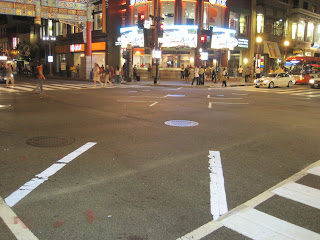
I am in Tokyo to present information about how the City of Portland is using traffic signals to reduce our environmental load. The presentation is approximately 18 hours from when I landed at Narita airport, so I may not be at my best without another cup of coffee!
Here are the initial pictures from my visit. The first photo is the view from my hotel room which is the Grand Prince Hotel Akasaka. I am on the 35th Floor and the room is spacious and comfortable. The view is very nice and I am close to the Imperial Palace and the Nagatacho Station on the Hanzomon Line. It's a great spot to start the visit.
I have brought gifts for my hosts as is customary in Japan. I found some great things to put in the Made in Oregon bag including candleholders made from recycled bike parts from Resource Revival, a variety of chocolate covered treats from the Made in Oregon store, chocolate covered coffee beans from Coffee People and coffee from Portland Roasting. I got a book from Powells at the airport that includes aerial photos of Portland and its surroundings, so I think this will be recieved well.

The initial perspectives I have on arrivals is that Tokyo is a late night town. I awoke at 5:30 AM today and was on the streets by 6. Walking around I found there weren't many shops open until 7 AM, even the coffee shops and no one has free WiFi. I am stuck paying $20 equivalent at the hotel! There was a rumor that McDonalds had free WiFi, but it turned out false (at least the one that I went to).
I am doing a bit of catch up with work email as well since I am travelling on behalf of the City and am grateful for the opportunity to participate in this exchange.
I am keeping an eye out for transportation facilities as always and found a few things that are worth considering for Portland.

The first example was a cross bike (adjacent to the crosswalk) that creates some facilities for people on bicycles that wouldn't otherwise have a connection clearly delineated. I'd be interested in their practice for implementation and when they choose to do this off-street and when on-street. I probably won't have much opportunity to talk with bicycle planners at this conference, since is primarily technology related.
The pedestrian indications are a mixed bag and they may be in the transition phase between the old style, which appear to be backlit light blue signs for walk and red don't walk indications. It appears they are going to a green walking person and a red don't walk. They flash the Walk indication to indicate when to clear the intersection, which is slightly different from our message. It does make me wonder whether we should flash the Walk when it is becoming stale and you're close to changing. It's a pretty small change that could improve information for peds.
They also add a sign adjacent to the pedestrian indications which I can't translate. I will ask about this at the meeting.


















